Achieve a positive digital end user experience with proactive website monitoring
In the modern era of technology, customers have high expectations for websites to be quick, dependable, and user-friendly. As the virtual representation of a company, a website plays a vital role in its success, making it essential for businesses to prioritize its efficient operation and top-notch performance. Any instances of downtime or sluggish loading speeds can result in end user frustration and a negative impression of the company. To guarantee a seamless and satisfactory experience for users visiting your site, it is crucial to have a strong website monitoring solution in place.
What is website monitoring?
Website monitoring is the process of continuously tracking a website's performance and availability on the internet to ensure it is functioning properly and providing a good user experience. As the name indicates, it involves keeping a constant watch on how your website is performing and taking appropriate measures to resolve issues in case of downtime or slowdowns. Whenever a page faces or is prone to face any sort of performance degradation, it is tracked quickly and necessary measures are taken to resolve problems as soon as possible with the help of website monitoring tools.
Why is website monitoring important?
Your website plays a crucial role in serving as the face of your company, making it necessary to provide an exceptional digital user experience to maintain a positive brand reputation. However, there are numerous possibilities that could cause your website to encounter performance issues, such as downtime, slow page loading, high web traffic, or unexpected security breaches, which can significantly disrupt your daily business operations and make the end user experience difficult, leading to frustration, loss of trust, and ultimately, a negative impression for your users. In a highly competitive market, a negative online experience can also drive potential customers to your competitors.
While it is impossible to prevent unexpected website performance issues completely, taking precautionary measures or, at the very least, staying cautious enough to avoid such problems is crucial for businesses to ensure their website remains operational and active for end users across the globe. Additionally, it is essential to analyze website performance beforehand to identify potential issues and take quick corrective actions to ensure an improved end user experience in real time. To achieve that, having robust website monitoring software in place is necessary.
What are the challenges faced in website monitoring?
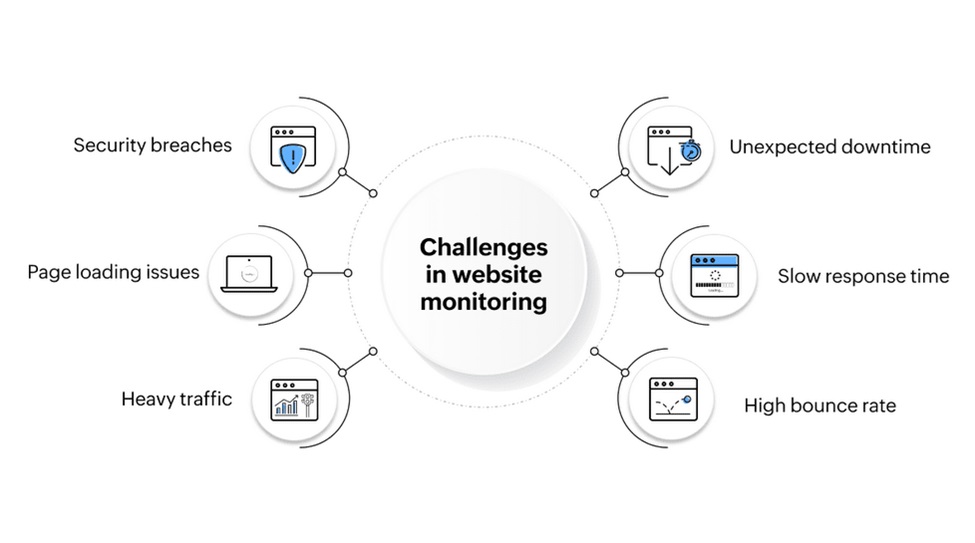
There are a multitude of reasons why a website may experience downtime. Some of these issues can be resolved by addressing problems in the backend servers, while others are caused by external factors that cannot be avoided. Regardless of the reasons, the following challenges are commonly observed in website monitoring:
- Unexpected downtime: Your business operations can be impacted at a greater scale due to unprecedented fluctuations in the health and availability of your website, especially during peak times of the day.
- Slow response times: A noticeable delay in the loading time of your webpages can reveal significant issues with your website's performance, causing frustration for end users.
- High bounce rates: A significant decrease in the number of users visiting your website's pages may indicate issues with usability and performance, which can negatively affect your website's score and brand reputation.
- Heavy traffic: A sudden increase in the number and frequency of web requests or actions can cause a significant load on servers hosting the website, which might directly affect the performance of the website.
- Page loading issues: The flow of the website journey for your end users is greatly affected by irregular content delivery on various devices, browsers, and regions caused by session or connection timeouts.
- Security breaches: Your website's integrity can be compromised by hackers who inject malicious content or software or attempt phishing, potentially leading to website blacklisting.
What are the key features of website monitoring?
A reliable website monitoring solution should offer comprehensive insights into the performance of your website across different parameters and promptly alert you in case of anomalies in real time. The following are the essential components that are involved in website monitoring:
Tracking individual webpage URLs
The most important aspect to consider in website monitoring is to guarantee that your website is functioning properly and without any problems. Even if a single webpage URL experiences slow loading times, there is a significant risk that visitors will lose interest in exploring the website, leading to decreased web traffic. Additionally, it is crucial to monitor and analyze the specific URLs that online visitors frequently access on your website as part of a web transaction sequence to help you identify and address any possible problems that may arise.
Simulating web user transactions
Once your website is live and accessible online, it is essential to determine if it is functioning effectively for end users who visit the site. It becomes crucial to track the end user's website journey, evaluate the performance of each step in a web transaction, and analyze specific components or bottlenecks that are impacting your website performance with in-depth insights, mainly for business-critical transactions like online banking or making purchases on an e-commerce platform.
Tracking real user behavior patterns
It is common for websites to encounter unexpected performance problems, regardless of how closely their performance is monitored. Sometimes, users may face sudden difficulties while carrying out real-time web transactions, making it challenging to identify the specific element of the website causing the disruption. Therefore, it is vital to get complete visibility into how your end users are interacting with your website in real time.
Analyzing webpage performance
It is important to analyze the performance of your webpage to monitor different elements of your website. Closely monitoring the functionality of your webpage by identifying and analyzing specific components that are causing slowdowns is essential so you can take immediate measures to rectify these issues.
Identifying defaced content
Companies often encounter website defacement as a major issue in web security. Hackers persistently try to breach webpage security by gaining unauthorized entry and unlawfully altering the webpage's content. This leads to compromised data security and disrupts business operations, introducing the need to track defaced or modified content in the website and have alerts be triggered instantly for optimal web security.
Maintaining positive brand reputation
Ensuring a positive impression for users visiting a website is crucial for both start-ups and major business conglomerates, especially with an interactive website. It is essential to prioritize maintaining a good brand reputation for the website to establish a seamless and positive online presence on the internet as well as to safeguard it from blacklisting.
Boost your website's performance with the best website monitoring tool
You need a proactive website monitoring solution that can track website performance to ensure an enhanced web user experience and positive user satisfaction. Here's what Applications Manager's website monitoring tool offers to help you obtain in-depth visibility into your website performance in real time:
URL monitoring
Applications Manager's URL monitoring feature allows you to monitor the availability and performance of important URLs on your websites, whether they are on the internet or intranet. It ensures the smooth functioning of your websites by tracking the response time of each URL and promptly notifying you of any delays in page loading. You can simulate a sequence of commonly accessed URLs by visitors and analyze them to identify and resolve any potential issues with ease.
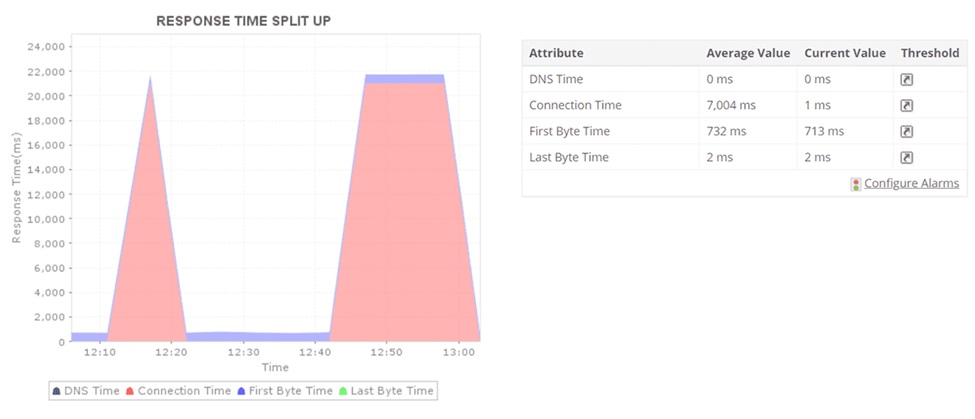
Synthetic transaction monitoring
Applications Manager's synthetic transaction monitoring is essential for monitoring your website's performance from an end user's point of view. By simulating important user navigation paths performed on a real web browser, it allows you to proactively identify and resolve potential issues before they impact actual end users. With the ability to record and replay simulated transactions that are crucial to your business, you can easily analyze specific components or bottlenecks that may affect your website's performance, gaining valuable insights to improve the user experience.
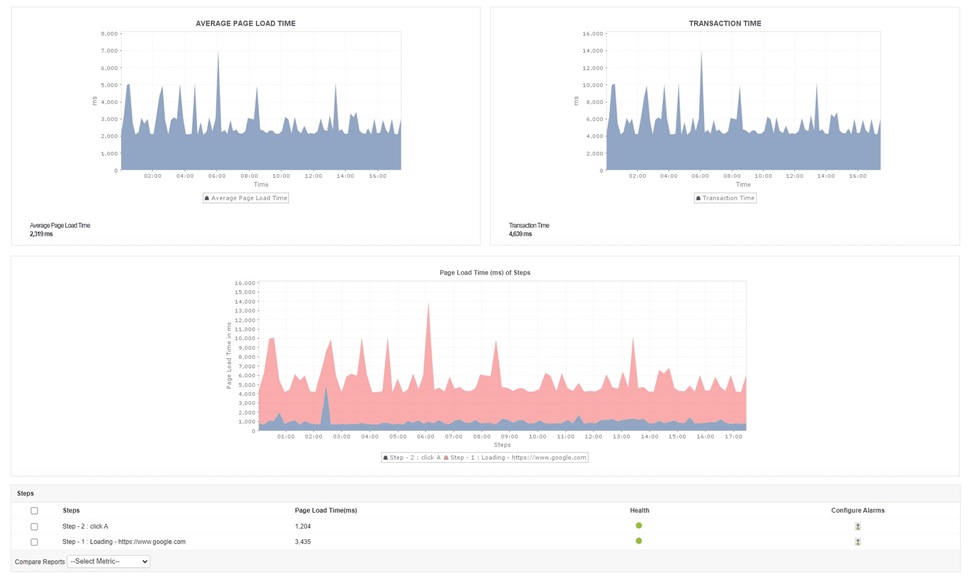
Real user monitoring
Applications Manager's real user monitoring is crucial in improving the digital user experience of your website, and it offers real-time insights. It plays a crucial role in continuously monitoring your website's performance across various locations by tracking important key performance indicators, and it provides deep visibility into how actual users interact with your website based on actual traffic, enabling you to gain a better understanding of their perspectives in real time. Additionally, it offers detailed insights into website performance based on factors such as geographies, browsers, devices, and ISPs, allowing you to make informed decisions for improving the overall user experience. This feature is a must-have for any website owner looking to ensure optimal performance and real-time user satisfaction.
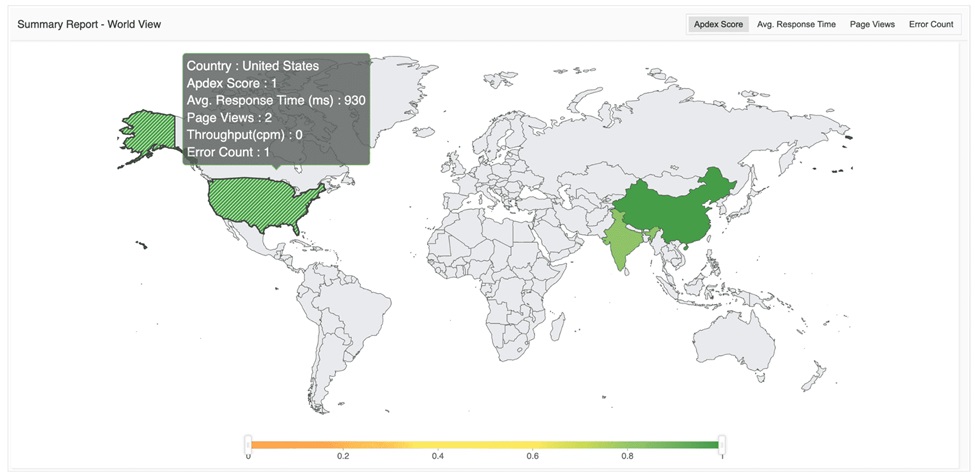
Webpage analyzer
Applications Manager's webpage analyzer feature provides a thorough analysis of webpage performance by identifying and examining the specific elements that cause slower performance. It examines the efficacy of the page by monitoring various factors such as response time, page size, resource size, and request count to evaluate the efficiency of your webpage. Additionally, it offers in-depth insights into your website's page speed, presenting scores and grades based on different rules for webpages, aiding you in identifying areas where your webpage may need improvement in terms of performance.
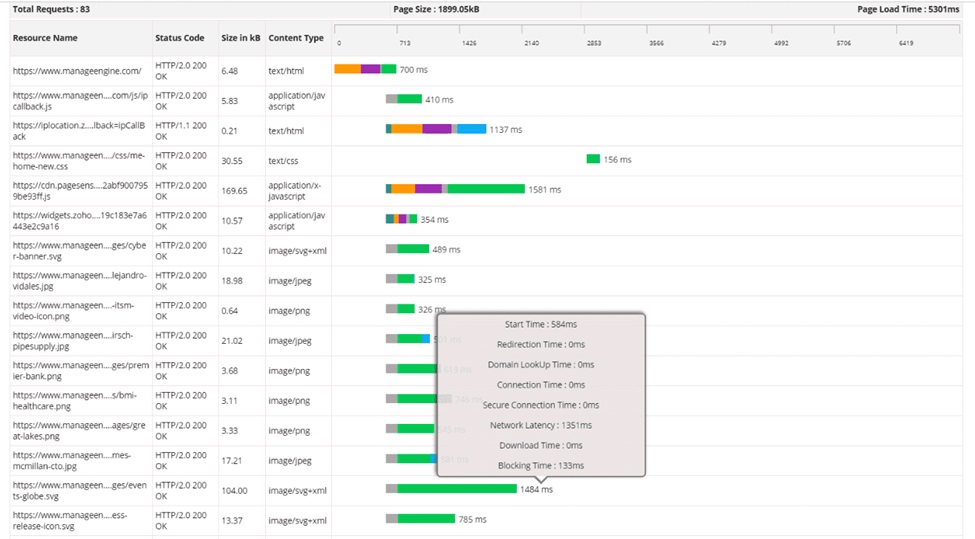
Website content monitoring
Website content monitoring in Applications Manager plays a crucial role in ensuring the security and integrity of your website. It works tirelessly to continuously check the integrity of your website's content, and it monitors and records any modifications made to essential HTML elements such as text, scripts, images, anchors, iframes, and links. It promptly notifies you of any detected changes in the webpage's content, allowing you to take immediate action to address any potential security threats. With website content monitoring in Applications Manager, you can rest assured that your website's content is always secure and protected.
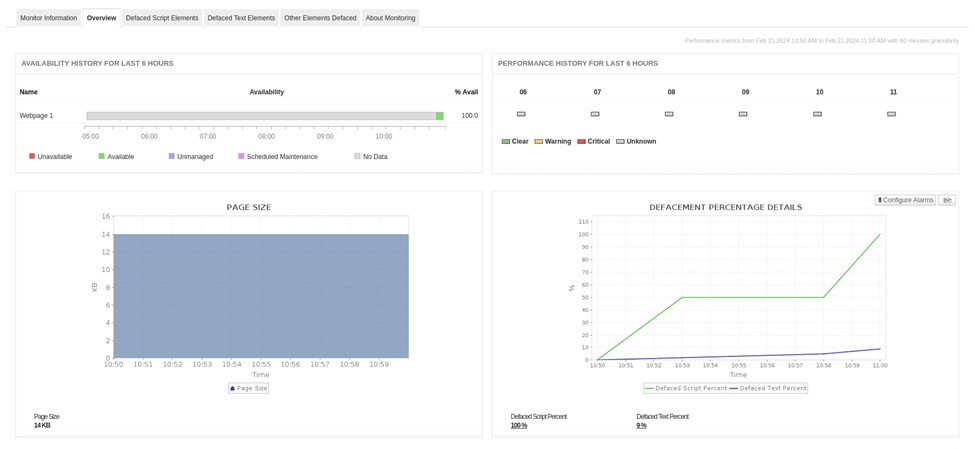
Brand reputation monitoring
Applications Manager's brand reputation monitoring helps ensure that you uphold a positive brand image for your website and prevents it from being blocklisted. It constantly checks the URLs of your website and alerts you whenever a webpage is detected to contain malware, phishing, or undesirable software, using the updated Web Risk list from Google. This way, you can ensure a seamless and positive online presence on the internet.

Applications Manager efficiently tracks website performance at multiple levels and promptly notifies users of any problems. By thoroughly monitoring website performance and other key performance indicators, you can guarantee a smooth and satisfactory digital experience for end users without any hassles.
You can experience the capabilities of Applications Manager by downloading a 30-day, free trial or by scheduling a free, personalized demo with our experts.
About the author
Arshad Shariff is a technical content writer at ManageEngine, a division of Zoho Corporation. He actively contributes to content on the application performance monitoring domain within the IT Operations Management suite. He delivers content through user guides, blogs, articles, and webpages that are simple to comprehend for readers with ease.

